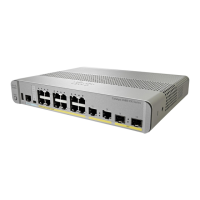39-64
Catalyst 3750-X and 3560-X Switch Software Configuration Guide
OL-21521-01
Chapter 39 Configuring QoS
Configuring Standard QoS
Step 11
policy-map policy-map-name Create an interface-level policy map by entering the policy-map name,
and enter policy-map configuration mode.
By default, no policy maps are def
ined, and no policing is performed.
Step 12
class-map class-map-name Define an interface-level traffic classification, and enter policy-map
configuration mode.
By default, no policy-map class-maps are defined.
If a traffic class has already been defined by using the clas
s-map global
configuration command, specify its name for class-map-name in this
command.
Step 13
police rate-bps burst-byte [exceed-action
{drop | policed-dscp-transmit}]
Define an individual policer for the classified traffic.
By default, no policer is defined. For information on the number of
pol
icers supported, see the “Standard QoS Configuration Guidelines”
section on page 39-36.
• For rate-bps, specify average traffic rate in bits per second (b/s).
The range is 8000 to 1000000000.
• For burst-byte, specify the normal burst size in bytes. The range is
8000 to 1000000.
• (Optional) Specify the action to take when the rates are exceeded.
Use the exceed-action drop keywords to drop the packet. Use the
exceed-action policed-dscp-transmit keywords to mark down the
DSCP value (by using the policed-DSCP map) and to send the
packet. For more information, see the “Configuring the
Policed-DSCP Map” section on page 39-72.
Step 14
exit Return to policy-map configuration mode.
Step 15
exit Return to global configuration mode.
Step 16
policy-map policy-map-name Create a VLAN-level policy map by entering the policy-map name, and
enter policy-map configuration mode.
By default, no policy maps are defined.
The default behavior of a policy map is to set the DSCP to 0 if the
pa
cket is an IP packet and to set the CoS to 0 if the packet is tagged. No
policing is performed.
Step 17
class class-map-name Define a VLAN-level traffic classification, and enter policy-map class
configuration mode.
By default, no policy-map class-maps are defined.
If a traffic class has already been defined by using the clas
s-map global
configuration command, specify its name for class-map-name in this
command.
Command Purpose

